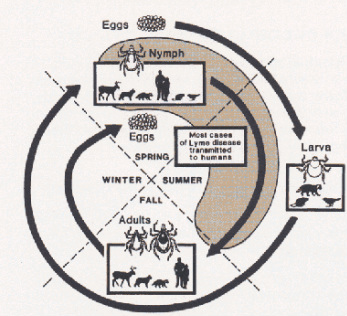Life Cycle

Life cycle of Lyme disease ticks
The tick life cycle has three unique stages consisting of the larva, nymph, and adult stages. The nymph stage is distinct in that the tick must go through several nymphal stages in order to grow. For a tick to move from stage to stage, it must intake blood. The tick larvae and nymphs usually become infected with Borrelia burgdorferi when they feed on infected small animals like the white-footed mouse. The bacteria stay in the tick as it moves from the larva stage to the nymph stage or from the nymph stage to the adult stage. Infected nymphs and adult ticks then continue their normal behavior of feeding on other hosts such as rodents, animals and humans, and transmitting the bacteria to them. A tick completes its life cycle after two years and as an adult, prefers to feed on the white-tailed deer. Lyme disease also occurs in domestic animals such as dogs. Additionally, domestic animals can carry infected ticks into areas of human life.
